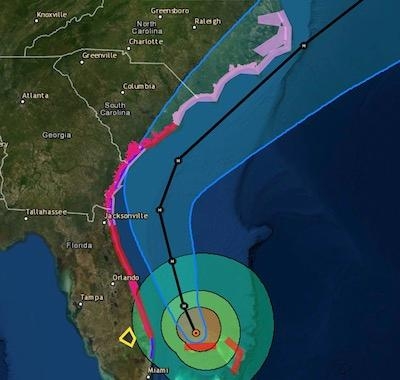Storm Affecting Airports Along The East U.S. Coast
The FAA is closely monitoring Hurricane Dorian, which is expected to remain a catastrophic hurricane during the next few days.

The agency has a team ready to to go to the Bahamas after the storm passes to assess any damage to FAA communications equipment. They are also preparing facilities and equipment in Florida, Georgia, South Carolina and North Carolina.
Airline passengers who plan to travel near the storm’s projected path, from Florida to North Carolina, should check flight status with their airline before heading to the airport. Airports make decisions about closing their facilities and may remain ‘open’ even after commercial flights have stopped. Airport status and general airport delay information is available at fly.faa.gov.
Airports in the area of potential impact make decisions about closing their facilities. In many cases, airports remain open and do not officially close even when flights have stopped. The FAA does not direct or advise airports to open or close.
The FAA maintains air traffic control radar coverage and provides service to flights for as long as possible. FAA control towers in hurricane-prone areas are designed and built to sustain hurricane force winds. Each control tower has a maximum wind sustainability, which can range from 55 to 75 miles per hour. When winds approach those speeds, controllers evacuate the tower cabs. At busy airports controllers remain in the building at a secure lower level, and are ready to go back to work as soon as the storm passes.
After the storm, the FAA assess damage to its facilities and navigational aids. It sets priorities to quickly re-establish critical equipment. The FAA has equipment, supplies and people ready to move into the affected areas as soon as the storm passes to restore air traffic control facilities that may be damaged by Hurricane Dorian. Teams of technicians and engineers from other locations travel to the affected areas to assess damage and begin restoring equipment and facilities working closely with the local technical teams.

Drone users should check NOTAMs and TFRs and avoid flying in areas where drones are prohibited.
Drone pilots must comply with FAA rules and should:
- Avoid flying in the area unless conducting an active disaster response or recovery mission.
- Be aware that the FAA might issue a TFR in the affected area. Be sure to check for active TFRs if you plan to fly.
- Remember that you cannot fly inside a TFR without FAA approval.
Drone emergency operations and response:
- During a natural disaster, do not fly your drone in or around emergency response efforts, unless you have special authorization to do so. There are low flying aircraft as part of the storm response — mostly in low visibility areas. If you are flying, emergency response operations cannot.
- You may be able to get expedited approval to operate in the TFR through the FAA’s Special Governmental Interest (SGI) process as outlined in FAA Order JO 7200.23A. Submit an Emergency Operation Request Form (MS Word) with your existing Remote Pilot Certificate or existing Certification of Authorization (COA) — and send to the FAA's System Operations Support Center (SOSC) at 9-ator-hq-sosc@faa.gov.
Be aware that significant penalties that may exceed $20,000 if drone operators interfere with emergency response operations. Flying a drone without authorization in or near the disaster area may violate federal, state, or local laws and ordinances, even if a TFR is not in place. Allow first responders to save lives and property without interference.
If you are not certified as a remote pilot or do not already hold a COA, you cannot fly.
(Source: FAA. Images from file)
 ANN's Daily Aero-Term (04.26.24): DETRESFA (Distress Phrase)
ANN's Daily Aero-Term (04.26.24): DETRESFA (Distress Phrase) ANN's Daily Aero-Linx (04.26.24)
ANN's Daily Aero-Linx (04.26.24) Airborne 04.22.24: Rotor X Worsens, Airport Fees 4 FNB?, USMC Drone Pilot
Airborne 04.22.24: Rotor X Worsens, Airport Fees 4 FNB?, USMC Drone Pilot Airborne 04.24.24: INTEGRAL E, Elixir USA, M700 RVSM
Airborne 04.24.24: INTEGRAL E, Elixir USA, M700 RVSM Airborne-NextGen 04.23.24: UAVOS UVH 170, magni650 Engine, World eVTOL Directory
Airborne-NextGen 04.23.24: UAVOS UVH 170, magni650 Engine, World eVTOL Directory




